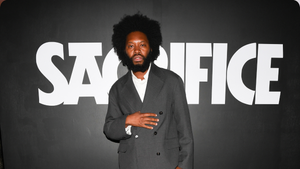We love a queen who knows her history.
RuPaul’s Drag Race’s Soa de Muse may have been the electric queen who sashayed into the hearts of fans — first on Drag Race France and now Global All Stars — and whose recent elimination from the latter left them heartbroken. Still, she will forever have a place in my heart for honoring our past in the art of drag. In one of her latest runway looks, the French queen paid homage to William Dorsey Swann, a 19th-century drag queen who paved the way for every queen who steps onto the Drag Race runway.
“For me, it was, what can I say? It was an opportunity,” Soa told PRIDE in an interview following her exit.
Let’s take a moment to step back into the queer time machine—your finest Victorian-era bustles are not required.
It’s not the era we often associate with drag ballrooms and house mothers, but that’s precisely what we’ll find in Swann: a former enslaved person turned drag queen and activist. She is widely regarded as the first “queen of drag.” Can you imagine being that fabulous in a time when being Black and gay, let alone publicly donning a wig and gown, was considered an act of rebellion?
But that’s what William Dorsey Swann did. In the 1880s, Swann organized secret drag balls in Washington, D.C., which would have had even the fiercest of queens today shaking in their stilettos. She faced police raids, arrests, and the constant threat of violence. Yet, she persevered, fighting for the right to celebrate her identity and her community.
Long before the fabulous, glittering world of RuPaul’s Drag Race, well before the voguing scenes portrayed in Paris is Burning, and long before that brick was thrown at Stonewall, Swann fought for our right to serve looks and live authentically.
As house mother, Swann's gathering consisted of formerly enslaved individuals and drag queens of the time, known as the "House of Swann." One of the dances they participated in was the cakewalk. Once performed by enslaved Americans in Southern plantations in a semi-minstrel manner, it was reclaimed with improvisational movements and expressions that resemble our modern voguing.
In the late 1800s, Swann and others were arrested and charged for running a brothel and sentenced to a few months in jail. Though Swann failed to get a presidential pardon, they left another historic moment for the books: becoming the first American to legally defend our community's right and dignity to gather freely and without violence.
Sadly, there are no credible surviving images of Dorsey today, so de Muse had several references to source for her look. Soa looked to Swann’s contemporary and friend, Jack Brown, for inspiration. An American drag performer who went to France and later performed in a cabaret, Brown was one of the earliest drag performers photographed.

Courtesy of World of Wonder
“So I’m gonna try to connect with [Mr. Brown’s image and story] and do this kind of Afro-futurism vision about who is William Dorsey Swann,” de Muse told us.
Swann stopped hosting drag events and died in 1925, aged 65. Today Swann is a historical figure who has largely been forgotten, but her legacy is now being rediscovered and celebrated. We have to thank Soa de Muse for embodying that legacy.
As the music played and the credits rolled at the end of this week’s episode, I wondered how we honor our drag ancestors in a world that often tries to forget them. Perhaps it’s through queens like Soa who remind us that drag is not just a performance—it’s a way of life. A celebration of identity. And the most artful form of protest.
So, as we say au revoir to Soa this season, let’s not mourn her departure. Instead, let’s celebrate her for what she truly is: a revolutionary. A queen like Dorsey reminds us that drag is history, drag is activism, and, most importantly, drag is forever.
Marie-Adélina de la Ferrière is the Community Editor at equalpride, publisher of Pride.com.
Voices is dedicated to featuring a wide range of inspiring personal stories and impactful opinions from the LGBTQ+ and Allied community. Visit pride.com/submit to learn more about submission guidelines. We welcome your thoughts and feedback on any of our stories. Email us at voices@equalpride.com. Views expressed in Voices stories are those of the guest writers, columnists and editors, and do not directly represent the views of PRIDE.com or our parent company, equalpride.


















































































